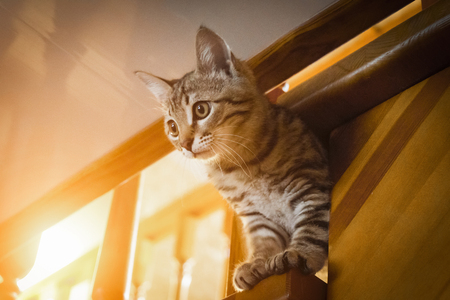Understanding Nighttime and Daytime Routines
When it comes to creating a cozy and productive environment at home, understanding the unique habits of nighttime and daytime is essential—not just for us, but for our pets as well. During the day, both people and animals tend to be more active, soaking up sunlight, playing outside, or tackling daily chores. The hustle and bustle of daytime routines help keep us energized and focused. On the flip side, nighttime brings a slower pace. It’s when we wind down, seek comfort, and prepare for restful sleep. Our furry friends often mirror these patterns: dogs might nap during the day but become extra cuddly as evening falls, while cats might have their own mysterious midnight adventures. Recognizing these differences is key to setting up spaces that cater to everyone’s needs—whether that means a sunny window seat for your cat to bask in the afternoon or a quiet, dim corner with soft blankets for you and your pup to snuggle into after dark. By tailoring our environments to suit both daytime energy and nighttime calm, we foster harmony and well-being for the whole household.
Lighting: Setting the Mood for Each Time of Day
Lighting is one of the most essential elements when creating an ideal environment that suits both nighttime and daytime habits. In many American homes, lighting choices are more than just practical—they help set the mood and support healthy daily rhythms for everyone in the house, including pets.
The Power of Lighting Choices
During the day, bright and natural light is often preferred. It energizes family members, supports productivity, and boosts mood. Many Americans love letting sunlight flood into living spaces with large windows or skylights, while also using cool-toned LED bulbs in workspaces or kitchens. In contrast, as evening arrives, it’s time to switch to softer, warmer lighting. Cozy table lamps, string lights on the porch, or even dimmable ceiling fixtures can transform a bustling space into a relaxing retreat perfect for winding down with loved ones—two-legged or four-legged!
Daytime vs. Nighttime Lighting Preferences
| Time of Day | Lighting Type | Purpose/Effect | Common Fixtures in American Homes |
|---|---|---|---|
| Daytime | Bright, Cool-Toned Light Natural Sunlight |
Energizes Enhances Focus Boosts Mood |
Large Windows LED Overhead Lights Desk Lamps |
| Nighttime | Soft, Warm-Toned Light Dimmed Lighting |
Promotes Relaxation Prepares for Sleep Makes Spaces Feel Cozy |
Lamps with Warm Bulbs Dimmable Fixtures Fairy or String Lights |
Cultural Habits and Daily Rhythms
American families often gather in the living room under gentle lamplight to enjoy evening TV shows or unwind with their pets curled up beside them. Meanwhile, mornings kick off in sunlit kitchens with coffee brewing and pets stretching out in sunbeams. This intentional adjustment of lighting throughout the day doesn’t just impact humans—it helps pets too! Dogs and cats tend to follow household routines, so consistent lighting cues support calm evenings and active days for all household members.

3. Temperature and Comfort: Cozy Nights, Energized Days
When it comes to building a home environment that supports both restful nights and energetic days, temperature control is key—especially across the diverse climate zones of the U.S. For those crisp New England evenings or chilly Midwest winters, setting your thermostat between 65–68°F (18–20°C) at night can help you snuggle in for quality sleep under a plush comforter or with your favorite pets by your side. Consider layering soft throws and using programmable thermostats to dial back the heat right before bedtime, saving energy while keeping things cozy.
During the day, especially in sunnier Southern or Western states, its all about staying cool and sharp. Adjust the thermostat up to around 72–76°F (22–24°C), use ceiling fans, or try energy-efficient air conditioners for a refreshing boost. Blackout curtains can block out harsh midday rays, while lighter cotton sheets and plenty of chilled water help everyone—two-legged and four-pawed family members alike—stay comfortable and focused.
For folks living in variable climates, smart home devices are popular for automating these shifts: set routines that lower temps in the evening and gently warm things up as morning arrives. Don’t forget beloved pets—make sure their bedding is placed away from drafts or direct sun, so they’re always as content as you are. With thoughtful adjustments, you can create a space that feels just right from sunrise to sunset (and beyond!), making every member of your household feel at home.
4. Noise and Activity Levels: Creating a Calming or Uplifting Atmosphere
Sound plays a major role in shaping our daily routines and overall well-being, especially when balancing nighttime and daytime habits in an American home. Whether you live in a bustling suburb with dogs barking at every passing mail truck, or on a quiet country lane where crickets lull you to sleep, crafting the right soundscape can help set the mood for both rest and productivity.
Using Soundscapes to Support Your Routine
At night, many people find that white noise machines or gentle nature sounds—like rainfall or ocean waves—help block out unpredictable noises (think: your neighbor’s late-night lawn mowing or your cat’s midnight zoomies). This consistent background hum can signal to your mind and body that it’s time to wind down. During the day, however, more lively soundtracks are often preferred. Upbeat playlists, podcasts, or even the gentle hum of household activity can motivate you through chores or work-from-home duties.
Managing Household Bustle—Especially with Pets
Pet-friendly homes bring their own unique soundtrack! While dogs may bark at delivery trucks and cats might chase sunbeams across hardwood floors, managing these natural noises is key. Consider scheduling active playtime for pets during daytime hours when increased energy fits right in with the household rhythm. At night, quieter activities like puzzle toys or snuggles can help pets—and humans—transition into a restful state.
Sound Environment Strategies: Day vs. Night
| Time of Day | Recommended Sounds | Tips for Pet Owners |
|---|---|---|
| Daytime | Cheerful music, podcasts, light conversation, natural outdoor sounds | Schedule walks & play; use toys to engage pets during active hours |
| Nighttime | White noise, soft instrumental music, nature sounds (rainfall, crickets) | Create a calm zone; offer quiet activities for pets; close windows to minimize outside noise |
The ultimate goal is to harmonize your household’s soundscape with your family’s (and furry friends’) rhythms. By curating uplifting sounds during the day and calming ones at night, you’ll create an environment where everyone—from energetic puppies to sleepy humans—can thrive.
5. Rituals and Routines: Building Consistency for Humans and Pets
Creating daily rituals is a cornerstone of both rural American living and modern work-life balance. When setting up an ideal environment that nurtures both daytime productivity and restful nights, routines benefit not just us, but also our pets. Country life often revolves around predictable rhythms—roosters crowing at dawn, dogs ready for their morning walk, and evenings spent winding down on the porch. These traditions are more than quaint—they’re deeply healthy for both people and animals.
Start with a Morning Energizer
Kick off your day with an energizing ritual that includes your furry friends. Whether it’s a brisk walk along a country lane or tossing a ball in the backyard, these shared moments help set a positive tone for everyone. Morning light is also vital—it regulates your circadian rhythm and helps pets distinguish day from night, encouraging better sleep later on.
Work-Life Balance Through Routine
Incorporate structured breaks into your day, reflecting the American appreciation for balancing productivity with well-being. Try scheduling short play sessions or cuddle breaks with your pets between work tasks, especially if you work from home or have a flexible rural schedule. This not only refreshes your mind but reassures your pets with consistent attention.
Evening Wind-Down Rituals
As dusk settles over fields and front porches alike, transition into nighttime by lowering household lights, turning off screens, and engaging in calming activities. Read a book while your cat purrs beside you or brush your dog as you listen to crickets outside. Soft music or gentle conversation helps everyone—two-legged and four-legged—shift toward restfulness.
Consistency is Key
No matter where you live, sticking to regular mealtimes, walks, and bedtime routines fosters security and trust for pets while promoting better sleep hygiene for humans. Over time, these rituals become cherished traditions that anchor your family’s days and nights.
Making Routines Enjoyable
Personalize rituals to suit your lifestyle—maybe Sunday morning means pancakes for you and an extra treat for your pup after chores are done. The goal isn’t perfection; it’s creating rhythms that nurture every member of your household in harmony with the natural world outside your door.
6. Leveraging Nature: Bringing the Outdoors In
One of the simplest ways to elevate both your daytime and nighttime habits is by inviting a touch of nature into your living spaces. Whether you’re an early riser who loves watching sunlight dance across the floors, or you cherish winding down with the soft hum of crickets outside your window, natural elements create harmony and comfort throughout the day.
Fresh Flowers & Greenery
Consider placing a vase of freshly picked wildflowers on your kitchen table or desk. Not only do they add a pop of color and brighten up the room, but studies show that being around greenery can boost your mood and help ease stress, making both mornings and evenings more enjoyable.
Sunny Windows for Pets
If you share your home with furry friends, setting up pet beds near sunny windows is a win-win for everyone. Cats love to bask in sunbeams, while dogs often nap contentedly in warm patches of light. Watching their peaceful routines reminds us to slow down and savor those gentle daytime moments. At night, those same spots can become cozy nooks for pets to curl up as the world quiets down.
Evening Porch Sits
There’s something magical about ending your day on the porch—mug of herbal tea in hand, maybe a dog or two at your feet—listening to the sounds of your neighborhood as dusk settles in. This simple ritual helps connect you to the rhythms of nature, signals to your mind that it’s time to unwind, and fosters a sense of place unique to American rural life.
By weaving these natural touches into your daily routine, you not only create a visually pleasing environment but also foster well-being for yourself—and your pets! Whether it’s soaking up sunshine or soaking in the evening calm, bringing the outdoors inside enriches every part of your day and night.
7. Personalizing the Environment: Tailoring Spaces for Everyone
Creating an ideal home environment means making sure everyone—from kids to canines—has a space that feels just right, whether it’s daytime or nighttime. Start by considering each family member’s unique needs and routines. For human members, think about hobbies and regional tastes: in the Midwest, a cozy reading nook with plaid throws and plenty of sunlight might be perfect for daytime relaxation, while a Pacific Northwest home could feature indoor plants and natural wood accents for a calming, nature-inspired vibe. At night, blackout curtains in bedrooms can help ensure restful sleep, while soft bedside lighting creates a soothing atmosphere.
For your four-legged companions, customization is just as important. Dogs with high energy might appreciate a corner filled with durable toys and a comfy bed near the family action during the day, but at night, they may prefer a quiet crate draped with a blanket in a peaceful corner. Cats love sunny windowsills by day and plush perches or heated beds at night. In Southern homes where porches are popular, set up pet-friendly spaces outside with water bowls and shaded spots for afternoon lounging.
If you have multiple pets, consider their personalities: shy pets often benefit from hideaways or elevated spaces, while social animals enjoy open areas near the heart of the household. Families who love crafts might dedicate a small sunroom to creative projects by day—and make sure there’s a secure spot for curious paws at night. Outdoor enthusiasts may want mudrooms with storage for hiking gear and easy-to-clean floors that welcome muddy boots (and paws) any time of day.
Personalizing your home also means adapting spaces seasonally. In winter, add cozy blankets and warm lighting; in summer, lighter linens and cooling fans keep everyone comfortable. Don’t forget regional flair—whether it’s rustic farmhouse touches in Texas or modern minimalism in California, let your family’s personality shine through.
Ultimately, setting up an ideal environment is about blending comfort and function so every member of your household—two- or four-legged—can thrive both during bright mornings and peaceful nights. With a little creativity and attention to individual needs, your home can truly be everyone’s favorite place to be.

